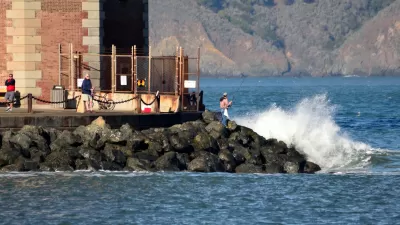The San Francisco Chronicle gives feature-length, in-depth treatment to the looming dangers of sea level rise, which are more likely to encroach on the built and natural environments of the Bay Area with every passing year.

John King writes of a profound challenge facing the San Francisco Bay Area: "to accommodate the bay’s impending expansion as it rises because of our warming planet."
An abundance of scientific studies says the bay’s average tide could climb several feet or more by 2100, with most change coming in the decades after 2050. It’s an inexorable shift that threatens low-lying neighborhoods as well as the fish, birds and wildlife that need tidal flats to survive.
After an aperture that tends toward the dire, King sounds a note of optimism: the Bay Area is presented with a window of time to prepare for the effects of climate change. Moreover, there are already success stories that exemplify the larger project facing the Bay Area. A concern emerging from those success stories, however, is how many years of planning, review, and construction required to deliver their benefits. To create the additional wetlands necessary to "absorb the worst impacts of sea-level rise later this century," according to King, "the Bay Area must overcome a protective mind-set that values time-consuming review processes above all else."
The political work King prescribes will have to take place at the Bay Conservation and Development Commission, created in 1965 for a different era of environmental and conservation concerns. The commission has taken steps, as recently as May of this year, but King notes how that effort still falls short of changing existing regulations.
The article is a long read, with a whole package of infographics, beautiful photography, and videos. The San Francisco Chronicle promises more coverage from King on the challenges of sea level rise, including the perils facing the city’s crumbling Embarcadero, the potential rebirth of the South Bay’s salt marshes and the creation of a small city on man-made Treasure Island. If the first article is any indicator, expect more thoughtful dialogue between the necessary steps to prepare the Bay Area for sea level rise and the forces that must be overcome, some human and some environmental, in the process.
FULL STORY: Rising reality

Planetizen Federal Action Tracker
A weekly monitor of how Trump’s orders and actions are impacting planners and planning in America.

Congressman Proposes Bill to Rename DC Metro “Trump Train”
The Make Autorail Great Again Act would withhold federal funding to the system until the Washington Metropolitan Area Transit Authority (WMATA), rebrands as the Washington Metropolitan Authority for Greater Access (WMAGA).

The Simple Legislative Tool Transforming Vacant Downtowns
In California, Michigan and Georgia, an easy win is bringing dollars — and delight — back to city centers.

The States Losing Rural Delivery Rooms at an Alarming Pace
In some states, as few as 9% of rural hospitals still deliver babies. As a result, rising pre-term births, no adequate pre-term care and harrowing close calls are a growing reality.

The Small South Asian Republic Going all in on EVs
Thanks to one simple policy change less than five years ago, 65% of new cars in this Himalayan country are now electric.

DC Backpedals on Bike Lane Protection, Swaps Barriers for Paint
Citing aesthetic concerns, the city is removing the concrete barriers and flexposts that once separated Arizona Avenue cyclists from motor vehicles.
Urban Design for Planners 1: Software Tools
This six-course series explores essential urban design concepts using open source software and equips planners with the tools they need to participate fully in the urban design process.
Planning for Universal Design
Learn the tools for implementing Universal Design in planning regulations.
Smith Gee Studio
City of Charlotte
City of Camden Redevelopment Agency
City of Astoria
Transportation Research & Education Center (TREC) at Portland State University
US High Speed Rail Association
City of Camden Redevelopment Agency
Municipality of Princeton (NJ)




























